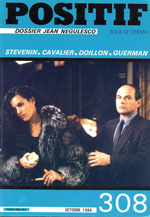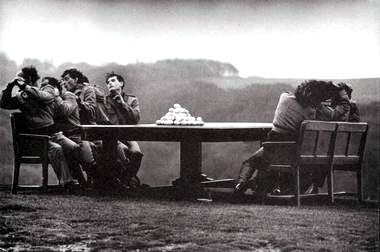Le Cinéma de Raoul Ruiz
Mammame
long métrage danse France (1986) 1h 05min.
Date de sortie : 23 Juillet 1986
Date de sortie : 23 Juillet 1986
Autre titre :
Réalisé par : Raoul Ruiz
Avec : Le groupe Emile Dubois : Eric Alfieri, Mathilde Altaraz, Muriel Boulay, Christophe Delachaux, Jean-Claude Gallotta, Pascal Gravat, Priscilla Newell, Viviane Serry, Robert Seyfried
Synopsis : Une troupe volubile, le corps bruni comme sous l'effet d'une grande chaleur, danse en s'invectivant dans un dédale de parois mobiles bleutées et festoie dans le vent au bord d'une falaise.
Scénario : Jean-Claude Gallotta, Raoul Ruiz
Montage : Martine Bouquin
D'après : une Création chorégraphique de Jean-Claude Gallotta
Production : Arcanal, Cinémathèque de la danse, Maison de la culture de Grenoble, Maison de la culture du Havre, groupe Emile Dubois, Théâtre de la Ville (Paris), Ministère de la culture
Image : Acácio de Almeida
Son : Jean-Paul Buisson
Musique : Henry Torgue, Serge Houppin
Costumes : Léo Standard
Mammame
Chicago Reader 1987
Jonathan Rosenbaum
Except for The Red Shoes, this shot-by-shot rethinking of a dance performance by the Emile Dubois Dance Group, choreographed by Jean-Claude Gallotta and directed by Raul Ruiz, could be the greatest dance film ever made. Running only 65 minutes, the 1986 film is as much a sensual workout as Ruiz's Life Is a Dream is an intellectual one; its celebration of pure physicality and movement is as exciting for film lovers as it is for dance enthusiasts. Using a Welles-inspired cinematography of wide angles, deep focus, shadows, silhouettes, and tilted perspectives, Ruiz and his gifted cameraman, Acacio de Almeida, join the spirited group of nine dancers not as detached observers or as competitors but as collaborators in the deepest sense of the word. Working through a continually mutable stage decor until the performance reaches a grand climax in the open air, by the sea, the film is almost as arresting aurally as it is visually, thanks to its natural sounds, music, and nonverbal utterances, all of which are superbly integrated with the physical movements. An exhilarating masterpiece, and in many respects Ruiz's most accessible work of the 80s.
Except for The Red Shoes, this shot-by-shot rethinking of a dance performance by the Emile Dubois Dance Group, choreographed by Jean-Claude Gallotta and directed by Raul Ruiz, could be the greatest dance film ever made. Running only 65 minutes, the 1986 film is as much a sensual workout as Ruiz's Life Is a Dream is an intellectual one; its celebration of pure physicality and movement is as exciting for film lovers as it is for dance enthusiasts. Using a Welles-inspired cinematography of wide angles, deep focus, shadows, silhouettes, and tilted perspectives, Ruiz and his gifted cameraman, Acacio de Almeida, join the spirited group of nine dancers not as detached observers or as competitors but as collaborators in the deepest sense of the word. Working through a continually mutable stage decor until the performance reaches a grand climax in the open air, by the sea, the film is almost as arresting aurally as it is visually, thanks to its natural sounds, music, and nonverbal utterances, all of which are superbly integrated with the physical movements. An exhilarating masterpiece, and in many respects Ruiz's most accessible work of the 80s.
----------
Cahiers du cinéma 387 1986
Le moi aimable
Katsahnias Iannis
----------
Positif 308 1986
Mammame
Eric Derobert

----------
Revue du Cinéma 419
Cahiers du cinéma 387 1986
Le moi aimable
Katsahnias Iannis
----------
Positif 308 1986
Mammame
Eric Derobert

----------
Revue du Cinéma 419
